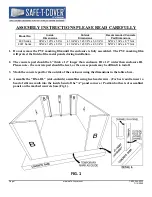
OUTLINE S.R.L.
Via Leonardo da Vinci, 56
25020 Flero (Brescia) Italy
Tel.: +39 030.3581341
Fax +39 030.3580431
info@outline.it
www.outline.it
7
The effect can therefore be almost completely com-
pensated, according to taste, requirements and ven-
ues’ particular acoustic characteristics, modifying
the system’s equalization as seen in the illustration
alongside (example of EQ via Outline Newton proces-
sor).
It is advisable to use a low-shelving filter with a
centre frequency of between 400 Hz and 500 Hz, am-
ple width and gain that is variable by -6 dB when the
number of elements is doubled, modifiable according
to requirements.
The low frequency section, thanks to the
coupling of adjacent sources and the geomet-
ric extension of the entire array, has the benefit
of greater directivity control: greater control of
the directivity of the low frequencies will be ob-
tained as the array’s effective length increases.
These simulations, carried out with Ope-
nArray2, confirm how the use of just 4 array
elements gives no advantage as far as verti-
cal directivity and sound reinforcement on the
mid-low frequencies (125 Hz – 500 Hz) are con-
cerned, with the same measurement distance
(15 m). On the other hand, when 8 or more el-
ements are used, the effects and advantages
of mutual coupling become clear and easily
predictable.








































